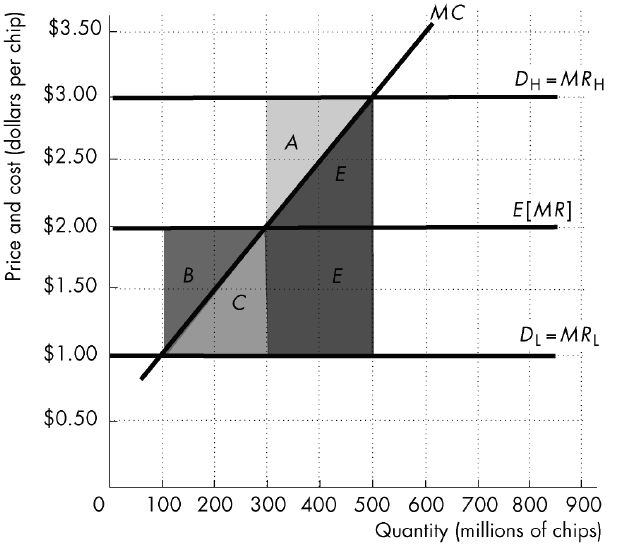Refer to Figure 23-4. Potential GDP equals $100 billion. The economy is currently producing GDP1 which is equal to $90 billion. If the MPC is 0.8, then how much must autonomous spending change for the economy to move to potential GDP?
A) -$18 billion B) -$2 billion C) $2 billion D) $18 billion
C
You might also like to view...
You are an analyst with a perfectly competitive firm that makes DRAM memory chips. You must manufacture the chips before you know what the demand will be. If demand turns out to be high, then producing where E[MR] = MC rather than where MRH = MC lowers your profit by an amount equal to ________.

A) area A
B) area A plus the trapazoidal area marked by E and E
C) the trapezoidal area marked by E and E
D) area B + area C
In the 1920s and 1930s, economists became increasingly aware that there were industries that did not fit the model of perfect competition or pure monopoly. Two separate theories of monopolistic competition resulted
Edward Chamberlin of Harvard published the Theory of Monopolistic Competition in 1933. Chamberlin defined monopolistic competition as A) a relatively large number of producers offering similar but differentiated products. B) a relatively small number of producers offering similar but differentiated products. C) a market situation in which a large number of firms produce identical products. D) a market situation in which a small number of firms produce similar products.
A duopoly is:
A. a strategy that benefits both firms. B. an agreement, explicit or implied, between two firms. C. an oligopoly with two firms. D. two firms agreeing to act like a joint monopolist.
Economic thinking suggests that a nation in which middlemen are considered to be unproductive seekers of profit, and where their activities are heavily restricted by law, will
a. gain by channeling people's efforts away from unproductive middleman activity toward physical output. b. lose the potential gains from trade that would result from lower transaction costs emanating from middleman activities. c. find that it is richer because the added transaction costs normally imposed by middlemen will be reduced. d. gain because the value of total output will rise.